十年探索
- 格式:ppt
- 大小:1.20 MB
- 文档页数:28
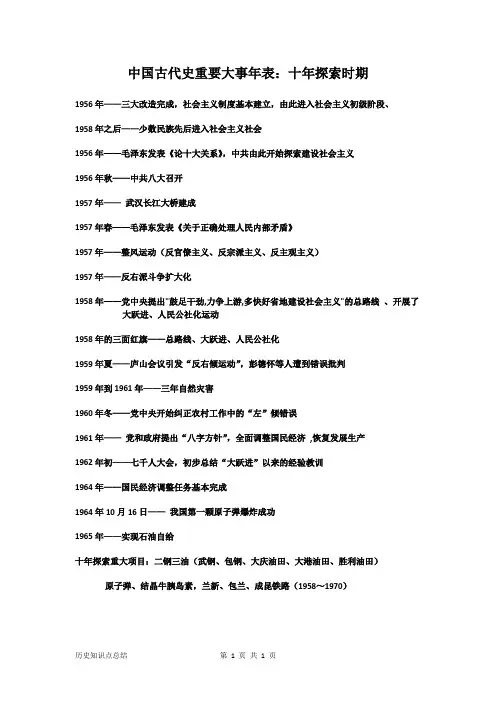
中国古代史重要大事年表:十年探索时期
1956年——三大改造完成,社会主义制度基本建立,由此进入社会主义初级阶段、
1958年之后——少数民族先后进入社会主义社会
1956年——毛泽东发表《论十大关系》,中共由此开始探索建设社会主义
1956年秋——中共八大召开
1957年——武汉长江大桥建成
1957年春——毛泽东发表《关于正确处理人民内部矛盾》
1957年——整风运动(反官僚主义、反宗派主义、反主观主义)
1957年——反右派斗争扩大化
1958年——党中央提出"鼓足干劲,力争上游,多快好省地建设社会主义"的总路线、开展了大跃进、人民公社化运动
1958年的三面红旗——总路线、大跃进、人民公社化
1959年夏——庐山会议引发“反右倾运动”,彭德怀等人遭到错误批判
1959年到1961年——三年自然灾害
1960年冬——党中央开始纠正农村工作中的“左”倾错误
1961年——党和政府提出“八字方针”,全面调整国民经济,恢复发展生产
1962年初——七千人大会,初步总结“大跃进”以来的经验教训
1964年——国民经济调整任务基本完成
1964年10月16日——我国第一颗原子弹爆炸成功
1965年——实现石油自给
十年探索重大项目:二钢三油(武钢、包钢、大庆油田、大港油田、胜利油田)
原子弹、结晶牛胰岛素,兰新、包兰、成昆铁路(1958~1970)
历史知识点总结第 1 页共1 页。




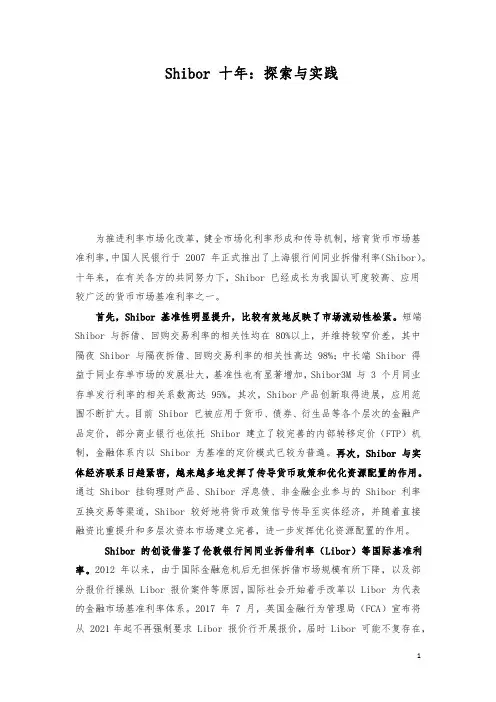
Shibor十年:探索与实践为推进利率市场化改革,健全市场化利率形成和传导机制,培育货币市场基准利率,中国人民银行于2007年正式推出了上海银行间同业拆借利率(Shibor)。
十年来,在有关各方的共同努力下,Shibor已经成长为我国认可度较高、应用较广泛的货币市场基准利率之一。
首先,Shibor基准性明显提升,比较有效地反映了市场流动性松紧。
短端Shibor与拆借、回购交易利率的相关性均在80%以上,并维持较窄价差,其中隔夜Shibor与隔夜拆借、回购交易利率的相关性高达98%;中长端Shibor得益于同业存单市场的发展壮大,基准性也有显著增加,Shibor3M与3个月同业存单发行利率的相关系数高达95%。
其次,Shibor产品创新取得进展,应用范围不断扩大。
目前Shibor已被应用于货币、债券、衍生品等各个层次的金融产品定价,部分商业银行也依托Shibor建立了较完善的内部转移定价(FTP)机制,金融体系内以Shibor为基准的定价模式已较为普遍。
再次,Shibor与实体经济联系日趋紧密,越来越多地发挥了传导货币政策和优化资源配置的作用。
通过Shibor挂钩理财产品、Shibor浮息债、非金融企业参与的Shibor利率互换交易等渠道,Shibor较好地将货币政策信号传导至实体经济,并随着直接融资比重提升和多层次资本市场建立完善,进一步发挥优化资源配置的作用。
Shibor的创设借鉴了伦敦银行间同业拆借利率(Libor)等国际基准利率。
2012年以来,由于国际金融危机后无担保拆借市场规模有所下降,以及部分报价行操纵Libor报价案件等原因,国际社会开始着手改革以Libor为代表的金融市场基准利率体系。
2017年7月,英国金融行为管理局(FCA)宣布将从2021年起不再强制要求Libor报价行开展报价,届时Libor可能不复存在,未来英国将逐步转向基于实际交易数据的SONIA(英镑隔夜平均利率)作为英镑市场基准利率。
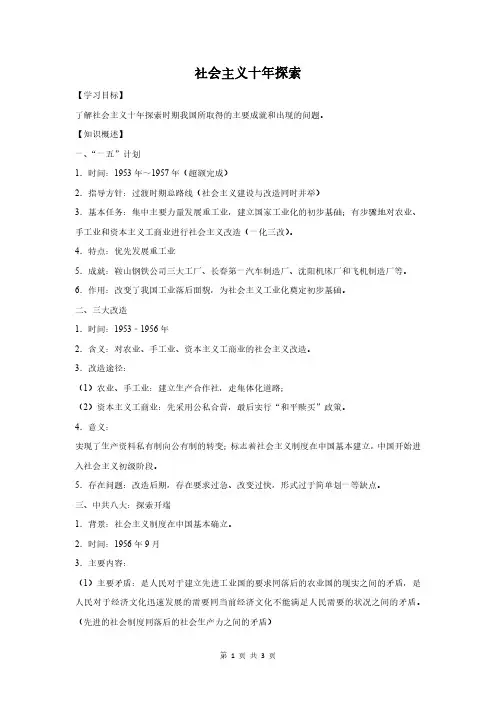
社会主义十年探索【学习目标】了解社会主义十年探索时期我国所取得的主要成就和出现的问题。
【知识概述】一、“一五”计划1.时间:1953年~1957年(超额完成)2.指导方针:过渡时期总路线(社会主义建设与改造同时并举)3.基本任务:集中主要力量发展重工业,建立国家工业化的初步基础;有步骤地对农业、手工业和资本主义工商业进行社会主义改造(一化三改)。
4.特点:优先发展重工业5.成就:鞍山钢铁公司三大工厂、长春第一汽车制造厂、沈阳机床厂和飞机制造厂等。
6.作用:改变了我国工业落后面貌,为社会主义工业化奠定初步基础。
二、三大改造1.时间:1953﹣1956年2.含义:对农业、手工业、资本主义工商业的社会主义改造。
3.改造途径:(1)农业、手工业:建立生产合作社,走集体化道路;(2)资本主义工商业:先采用公私合营,最后实行“和平赎买”政策。
4.意义:实现了生产资料私有制向公有制的转变;标志着社会主义制度在中国基本建立,中国开始进入社会主义初级阶段。
5.存在问题:改造后期,存在要求过急、改变过快,形式过于简单划一等缺点。
三、中共八大:探索开端1.背景:社会主义制度在中国基本确立。
2.时间:1956年9月3.主要内容:(1)主要矛盾:是人民对于建立先进工业国的要求同落后的农业国的现实之间的矛盾,是人民对于经济文化迅速发展的需要同当前经济文化不能满足人民需要的状况之间的矛盾。
(先进的社会制度同落后的社会生产力之间的矛盾)(2)主要任务:是把中国尽快地从落后的农业国变为先进的工业国。
4.意义:是对我国建设社会主义道路的一次成功探索。
四、大跃进和人民公社化运动1.原因:由于中国的社会主义实践刚刚起步,人们对于什么是社会主义、如何建设社会主义等问题在理论和思想上缺乏深刻认识,从而导致社会主义道路的探索过程开始出现曲折和失误。
2.开展:1958年,在急于求成和片面强调经济建设发展速度的错误思想指导,“大跃进”运动在全国范围内展开,接着全国农村大办人民公社。

对十年探索的评价及认识
(1)评价:1956~1966年这十年的探索是“两头好,中间差”,其整体特征是社会主义经济建设在探索中曲折前进,主流是前进的。
这是因为经济建设这个中心尚未转移,工作的失误尚局限于局部,错误延续的时间只集中在1958—1960年,错误还是在探索这个前提下出现的。
(2)认识:①凡是党和国家的方针政策能正确反映并适合中国国情时,就能推动建设事业的发展,反之则会遭到挫折和失败。
②社会主义经济建设必须自觉地按照客观规律办事,违背经济规律,就会受到惩罚。
③实事求是,一切从实际出发是党一贯的思想路线。
④在经济工作中有什么倾向就应当反对什么倾向,不能只反右不反“左”。
⑤从建设中遇到的挫折使我们认识了社会主义建设的长期性、艰巨性、复杂性,而所取得的成就更加坚定了我们建设有中国特色社会主义的信念。
⑥从曲折中取得的成就使我们认识到我们党是一个伟大的党,敢于正视并改正自身的错误,有能力解决自己的问题,社会主义具有强大的生命力,是任何反动势力都推翻不了的。

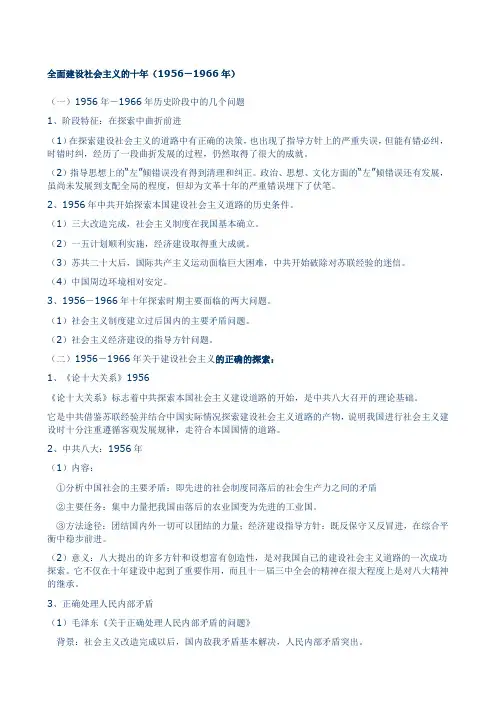
全面建设社会主义的十年(1956―1966年)(一)1956年-1966年历史阶段中的几个问题1、阶段特征:在探索中曲折前进(1)在探索建设社会主义的道路中有正确的决策,也出现了指导方针上的严重失误,但能有错必纠,时错时纠,经历了一段曲折发展的过程,仍然取得了很大的成就。
(2)指导思想上的“左”倾错误没有得到清理和纠正。
政治、思想、文化方面的“左”倾错误还有发展,虽尚未发展到支配全局的程度,但却为文革十年的严重错误埋下了伏笔。
2、1956年中共开始探索本国建设社会主义道路的历史条件。
(1)三大改造完成,社会主义制度在我国基本确立。
(2)一五计划顺利实施,经济建设取得重大成就。
(3)苏共二十大后,国际共产主义运动面临巨大困难,中共开始破除对苏联经验的迷信。
(4)中国周边环境相对安定。
3、1956-1966年十年探索时期主要面临的两大问题。
(1)社会主义制度建立过后国内的主要矛盾问题。
(2)社会主义经济建设的指导方针问题。
(二)1956-1966年关于建设社会主义的正确的探索:1、《论十大关系》1956《论十大关系》标志着中共探索本国社会主义建设道路的开始,是中共八大召开的理论基础。
它是中共借鉴苏联经验并结合中国实际情况探索建设社会主义道路的产物,说明我国进行社会主义建设时十分注重遵循客观发展规律,走符合本国国情的道路。
2、中共八大:1956年(1)内容:①分析中国社会的主要矛盾:即先进的社会制度同落后的社会生产力之间的矛盾②主要任务:集中力量把我国由落后的农业国变为先进的工业国。
③方法途径:团结国内外一切可以团结的力量;经济建设指导方针:既反保守又反冒进,在综合平衡中稳步前进。
(2)意义:八大提出的许多方针和设想富有创造性,是对我国自己的建设社会主义道路的一次成功探索。
它不仅在十年建设中起到了重要作用,而且十一届三中全会的精神在很大程度上是对八大精神的继承。
3、正确处理人民内部矛盾(1)毛泽东《关于正确处理人民内部矛盾的问题》背景:社会主义改造完成以后,国内敌我矛盾基本解决,人民内部矛盾突出。
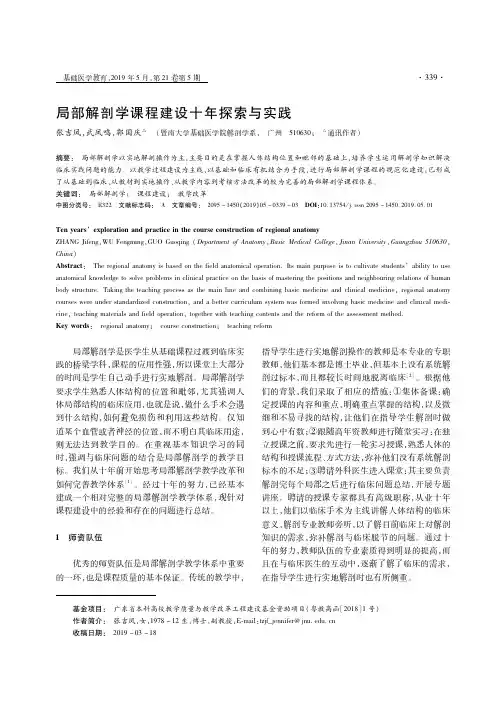
“石柱模式”:校地产学研合作十年探索一边是全国重点大学,一边是少数民族地区国家扶贫开发工作重点县。
西南大学与重庆市石柱土家族自治县10年深度合作,成功实现了地方脱贫致富奔小康和大学教学科研上台阶的共赢。
地方借助校地合作走出了一条依靠科技助推县域经济腾飞的富民强县之路,大学通过校地合作走出了一条服务社会与自身同步发展的兴校育人之路。
一、时代背景:高校服务社会的职责要求,地方对科技的急切需求石柱土家族自治县位于重庆东南部,是三峡库区唯一的少数民族自治县,也是国家扶贫开发重点县。
当地农业资源丰富,但由于自然条件的制约,交通不便,更兼科技力量薄弱,人才资源匮乏,导致经济发展水平较低,农业发展能力不强,农民收入水平不高。
2003年,全县农民人均纯收入仅为1686元。
石柱县意识到:“要在国家新的发展战略中抓住难得的发展机遇,实现经济社会的跨越发展,必须在依靠科技进步带动产业发展上狠下功夫;必须充分发挥资源优势,运用科技成果,延长产业链条,转变经济增长方式,走以科技支撑经济社会持续快速健康发展的新路子。
”西南大学是教育部直属“211工程”建设高校,在农业教育和农业科技方面有着突出优势和鲜明特色。
1997年,学校作为重庆市委农工委扶贫集团成员单位,就开始参与石柱县的对口帮扶工作,但这种短期、分散的“输血式”扶贫收效甚微,带动辐射效应不足,持续发展能力不够。
学校认为,学校的发展必须要同重庆的发展、西部的发展、国家的发展结合起来,统筹人才培养、科学研究、社会服务等职能,在引领和服务社会发展中促进自身发展。
学校决定调整原来的科技扶贫思路,经过深入调研,学校决定调动全校科教资源, 长期稳定在一个区域集中转化科研成果,帮助地方脱贫致富,真正实现大学的社会服务职能。
在这样的时代背景下,县校双方都面临着共同的任务,思考着共同的课题。
2003年10月,在重庆市委、市政府的支持下,学校与石柱县开始合作共建“石柱农业科技综合示范基地”。
第18讲社会主义建设在探索中曲折发展目录模拟.基础演练 (1)重难.创新演练 (4)真题.实战演练 (7)1.【十年探索时期】1956年毛泽东在论述未来国家工业化发展战略时提到:“如果没有足够的粮食和其他生活必需品,首先就不能养活工人,还谈什么发展重工业所以,重工业和轻工业、农业的关系,必须处理好。
”毛泽东这一主张()A.存在着左倾冒进的倾向B.强调产业平衡发展的必要性C.基于对苏联模式的反思D.要求农业技术进步的紧迫性2.【十年探索时期】1956年,党和国家对国民经济结构作出了一些调整:在城镇,分散了一部分过于集中的小手工业和小商业,个体经济和自由市场也有所恢复和增加;在农村,允许一部分生产资料如鱼塘、菜地、果园、桑园、成片林木等可以暂不入社,归原主经营等。
上述措施()A.增添了国民经济的活力B.反思了人民公社的弊端C.推动了国民经济的调整D.提高了农民的生活水平3.【工业、农业领域的成就】20世纪六七十年代,党和政府采用大会战模式推进铁路工程,设立以成昆线为中心的西南铁路建设指挥部,组建总数达30余万人的联合筑路大军,组织沿线地方政府开展支援铁路建设工作,成功修建了成昆、襄渝等一批铁路。
这一模式()A.使得中国基础设施建设走在世界前列B.折射出特定历史环境下国家政策选择C.促使西南地区整体性贫困得到了解决D.得益于社会主义市场经济体制的建立4.【工业、农业领域的成就】1966年2月2日,《上海市第三个五年计划绿化工作规划(草案)》发布,指出:“本市市郊面积大,地处国防前哨,海岸线长,绿化植树要多种快长、高大、荫浓的乔木,尽速把海岛、沿海沿江、山头、公路、部队驻地、工矿企业、农村四旁等地普遍绿化起来。
”据此可知,该规划()A.体现敢为人先的时代精神B.缓解了中国的外交困局C.重在提升应对风险的能力D.受“左”倾思想的影响5.【教育、卫生、文化领域的成就】如图所示为1956年中国政府发行的系列体育宣传画。
Views&CommentsThe Deep Carbon Observatory:A Ten-Year Quest to Study Carbon inEarthCraig M.Schiffries,Andrea Johnson Mangum,Jennifer L.Mays,Michelle Hoon-Starr,Robert M.Hazen Geophysical Laboratory,Carnegie Institution for Science,Washington,DC20015,USA1.OverviewThe Deep Carbon Observatory(DCO)is a ten-year research pro-gram to investigate the quantities,movements,forms,and origins of carbon in Earth.More than90%of Earth’s carbon may reside in the planet’s deep interior,and DCO’s overarching mission is to understand Earth’s entire carbon cycle—beyond the atmosphere, oceans,and shallow crustal environments,which have drawn most previous research attention—to include the deep carbon cycle[1,2].A decade of focused research has led to major discoveries by DCO scientists on the physical,chemical,and biological roles of carbon in Earth.To pursue its multidisciplinary mission,DCO connects more than1200scientists worldwide,broadly grouping them into four Science Communities:Extreme Physics and Chemistry,Reservoirs and Fluxes,Deep Energy,and Deep Life(Table1).The program also emphasizes four crosscutting activities that bridge community boundaries—namely,data science,instrumentation,field studies, and modeling and visualization—and several cross-community groups that provide essential services to the entire DCO commu-nity(Fig.1).In addition to its scientific advances,DCO has created an endur-ing legacy of interdisciplinary and international community build-ing,successfully establishing a diverse,dynamic,and collaborative community of geologists,physicists,chemists,and biologists in more than50countries.In particular,DCO has focused on cultivat-ing the next generation of deep carbon researchers by supporting early career scientists who will carry on the tradition of explo-ration and discovery for decades to come.The vision,guiding questions,and scientific goals of DCO were initially framed at an international Deep Carbon Cycle Symposium at the Carnegie Institution for Science in2008.This symposium led to a successful proposal to the Alfred P.Sloan Foundation to estab-lish a decadal research program on deep carbon science from2009 to2019.The Alfred P.Sloan Foundation pledged seed funding of50 million USD over ten years to foster DCO.DCO has leveraged the support from the Alfred P.Sloan Foundation with more than500 million USD in support from other sources,including international organizations,national science agencies,foundations,and the private sector.2.The Extreme Physics and Chemistry CommunityDCO’s Extreme Physics and Chemistry Community is dedicated to improving our understanding of the physical and chemical behavior of carbon at extreme conditions,as found in the deep interiors of Earth and other planets.This Community is making transformational advances in our understanding of carbon in min-erals,magmas and melts,and aqueousfluids at extreme condi-tions.DCO scientists have published new results on the properties of carbon-bearing minerals at high pressures and tem-peratures,including the structure,compressibility,and elasticity of carbonate minerals,carbides,carbon dioxide(CO2)ices,and clathrates.One discovery is the formation of phases with sp3 hybridization of carbon to yield tetrahedral coordination of carbon by oxygen at elevated pressure and temperature.Under ambient conditions,CO2is a linear molecule;however,at sufficiently high pressure,CO2transforms into a polymerized framework structure in which carbon is tetrahedrally coordinated with four oxygen atoms[3].Dense forms of polymeric CO2are potential reservoirs of carbon in planetary interiors.The stabilization of tetrahedrally coordinated carbon has profound implications if this carbon substi-tutes for tetrahedrally coordinated silicon in silicate minerals.This substitution mechanism has been verified experimentally[4],and indicates a potential reservoir for carbon in Earth and planetary interiors.DCO scientists have also conducted extensive research on carbonate minerals under extreme conditions.Under ambient conditions,carbon forms trigonal planar structural units in car-bonate minerals.At high pressure,carbonate minerals transform into denser structures in which carbon is tetrahedrally coordi-nated with four oxygen atoms[5–11]—a discovery that has important implications for the stability and properties of carbon-ates in the deep carbon cycle[12,13].Complementary experimen-tal studies of carbon in iron at extreme conditions provide conflicting evidence about the elusive role of carbon in Earth’s core[14–16].Magma ocean processes set the initial distribution of carbon and conditions for further development of Earth’s deep carbon cycle[17].Magmas are also the main agent for transporting carbon from Earth’s interior to its surface[18].Conversely,carbon influ-ences deep Earth dynamics by inducing melting and mobilizationof structurally bound mineral water [19].Melting may also have a major impact on the recycling of subducted carbon into the deep mantle.The melting-phase relations of recycled oceanic crust sug-gest that slabs undergo melting and loss of carbonate components in the transition zone,creating a barrier to deep carbon subduction [20].Recent experimental studies indicate that carbonatitic liquids provide a potentially significant pathway for carbon recycling at shallow depths beneath arcs [21].DCO is making rapid advances in our understanding of the role of aqueous fluids in the deep carbon cycle.Until recently,thermodynamic models developed to understand water-rock interactions in Earth’s upper and middle crust could not be extended to deeper environments,largely because the dielectric constant of water at extreme conditions was unknown.DCO sci-entists removed this barrier by conducting first-principles calcu-lations of the dielectric constant of water under extreme conditions and the transport of carbonates in the deep Earth[22].These calculations were used in combination with experi-mental results [23]to develop the Deep Earth Water (DEW)model [24].Initial results from the DEW model demonstrate that organic carbon plays an important role in subduction zone fluids [25]and that diamonds can form due to pH shifts in deep fluids [26].The role of carbon in setting the pH of subduction zone fluids can now be assessed,with implications for volatile and metal cycles [27].This approach is transforming our view of global geochemical transport [28].3.The Reservoirs and Fluxes CommunityDCO’s Reservoirs and Fluxes Community is dedicated to iden-tifying the principal deep carbon reservoirs,determining the mechanisms and rates by which carbon moves among these reservoirs,and assessing the total carbon budget of Earth.Table 1DCO decadal goals.DCO Science Community Decadal goalsExtreme Physics and ChemistrySeek and identify possible new carbon-bearing materials in Earth and planetary interiorsCharacterize the structural and dynamical properties of materials and identify their reactions and transformations at conditions rele-vant to Earth and planetary interiorsDevelop,extend,combine,and exploit experimental tools to investigate carbon-bearing samples in new regimes of pressure,temper-ature,and bulk compositionDevelop,extend,and improve databases and simulations of deep carbon material properties,reactions,and transport for integration with quantitative models of global carbon cyclingReservoirs and FluxesEstablish open access,continuous information streams on volcanic gas emission and related activity Determine the chemical forms and distribution of carbon in Earth’s deepest interiorDetermine the seafloor carbon budget and global rates of carbon input into subduction zonesEstimate the net direction and magnitude of tectonic carbon fluxes from the mantle and crust to the atmosphereDevelop a robust overarching global carbon cycle model through deep time,including the earliest Earth and coevolution of the geo-sphere and biosphereProduce quantitative models of global carbon cycling at various scales,including the planetary scale (mantle convection),tectonic scale (subduction zone,orogeny,rift,volcano),and reservoir scale (core,mantle,crust,hydrosphere)Deep EnergyUtilize field-based investigations of approximately 25globally representative terrestrial and marine environments to determine pro-cesses controlling the origin,form,quantities,and movements of abiotic gases and organic species in Earth’s crust and uppermost mantleImplement the use of DCO-sponsored instrumentation,especially revolutionary isotopologue measurements,to discriminate the abiotic versus biotic origin of methane gas and organic species sampled from global terrestrial and marine field sitesQuantify as a function of temperature,pressure,fluid and solid compositions,and redox state the mechanisms and rates of fluid-rock interactions that produce hydrogen (H 2),abiotic forms of hydrocarbon gases,and more complex organic compoundsIntegrate our quantitative understanding of the processes that control the origins,forms,quantities,and movements of abiotic vs.biotic carbon compounds with quantitative models of global carbon cyclingDeep LifeDetermine the processes that define the diversity and distribution of deep life as it relates to the carbon cycle Determine the environmental limits of deep lifeDetermine the interactions between deep life and carbon cycling onEarthFig.1.DCO organizational structure.C.M.Schiffries et al./Engineering 5(2019)372–378373Its Diamonds and Mantle Geodynamics of Carbon(DMGC)group has created an international infrastructure to study Earth’s deep interior through the unique record preserved in diamonds.DMGC aims to advance deep Earth exploration by studying natural diamonds and diamond-formingfluids and melts in order to elucidate carbon mobility in Earth through geologic time[29]. Because this effort hinges,in part,on sample availability and a coordinated effort toward sample research,DMGC is developing registered sample collections and a geochemical database of diamonds and diamond inclusions.The discovery of native metals,metal carbides,and reduced volatiles in large gem-quality diamonds indicates that these dia-monds formed from metallic liquid in Earth’s deep mantle,and provides broad implications for Earth’s evolution[30].In contrast, highly salinefluids from a subducting slab are the source for cer-tainfluid-richfibrous diamonds;the data imply a strong associa-tion between subduction,mantle metasomatism,andfluid-rich diamond formation,as well as pointing to the important effect of subduction-derivedfluids on the composition of the deep litho-spheric mantle[31].The discovery of hydrous ringwoodite included within an ultradeep diamond provides direct evidence of a hydrous mantle transition zone,which may have a key role in terrestrial magmatism and plate tectonics[32].The discovery of calcium silicate perovskite in a diamond that formed780km below Earth’s surface provides thefirst direct observation of Earth’s fourth most abundant mineral;the isotopic composition of carbon in the surrounding diamond,together with the pristine high-pressure CaSiO3structure,indicate the recycling of oceanic crust into the lower mantle[33].Blue boron-bearing diamonds contain mineral inclusions indicating that these diamonds formed in oceanic lithosphere that was subducted into Earth’s lower man-tle.Blue diamonds indicate a pathway for the ultradeep recycling of carbon,water,and other materials from the crust to the lower mantle and back to the surface[34].The Reservoirs and Fluxes Community’s Deep Earth Carbon Degassing(DECADE)initiative aims to determine accurate global fluxes of volcanic CO2to the atmosphere.To achieve this goal, DECADE has launched an intensivefield-based effort to install CO2-monitoring networks on20of the world’s150most actively degassing volcanoes.DECADE also conducts laboratory-based studies,which focus on using gas samples and melt inclusions to provide empirical constraints on carbon degassing to the atmosphere.High-frequency gas monitoring at Turrialba Volcano in Costa Rica revealed CO2precursors to eruptions,which lays the foun-dation for improved volcanic eruption forecasts[35].An interna-tional team led by DECADE members demonstrated that the Ambrym basaltic volcano in the Vanuatu Arc in the southwest Pacific Ocean ranks among the top-three known persistent emit-ters of volcanic gas at the global scale[36].There is growing evi-dence that continental rifts represent a major source of deep carbon released to Earth’s surface from both volcanoes and fault zones[37–40].New measurements of olivine-hosted melt inclu-sions from the Mid-Atlantic Ridge indicate that upper mantle carbon content varies by almost two orders of magnitude glob-ally,which can affect the dynamics of melting,the style of vol-canism,and the evolution of Earth’s atmosphere via planetary outgassing[41].For thefirst time in a global study,DCO scien-tists found evidence for higher carbon output(m(CO2)/m(S total), where m(CO2)and m(S total)are the amounts of CO2and total sul-fur,respectively)in volcanic arcs where carbonate sediment sub-ducts on the seafloor[42].A synthesis of global carbon and helium isotopic data from arc volcanoes concludes that the car-bon isotope composition of mean global volcanic gas is consider-ably heavier than the canonical mid-ocean ridge basalt value;this result indicates that reworking of crustal limestone is an important source of volcanic carbon,which has implications regarding the return of carbon to the deep mantle and for Earth’s past climate[43].Modeling and visualization of Earth’s deep carbon cycle through deep time contributes significantly to DCO’s overall goals.A reeval-uation of carbonfluxes in subduction zones indicates that almost all of the carbon in subducting sediments and oceanic plates may be extracted influids and melts,with relatively little carbon being returned to the convecting mantle[44].Plate tectonic reconstruc-tions establish connections between the deep carbon cycle and the concentration of CO2in the atmosphere over geologic time scales[45–47].Numerical models of the role of volatiles in reactive melt transport in the asthenosphere indicate that CO2and water, despite their low concentration,have an important control on the extent and style of magma genesis,as well as on the dynamics of melt transport and the stranding of carbon at the lithosphere–asthenosphere boundary;thesefindings have significant implica-tions for deep Earth degassing[48,49].4.The Deep Energy CommunityDCO’s Deep Energy Community is dedicated to developing a fundamental understanding of environments and processes that regulate the volume and rates of the production of abiogenic hydrocarbons and other organic species in the crust and mantle through geological time.This research is transforming our under-standing of methane(CH4)and includes novel information about its origin,provenance,and formation temperature.Revolutionary advances in instrumentation make it possible to discriminate between methane produced by abiotic synthesis and that produced by biological processes.The Panorama mass spectrometer is thefirst instrument capable of resolving the two doubly substituted mass-18 isotopologues of methane(‘‘clumped isotopes”)—13CH3D and 12CD2H2—at natural abundances[50].A paper by Edward Young and23co-authors from14institutions in eight countries[51] reports thefirst resolved measurements of two doubly substituted isotopologues of methane in gases collected from diverse geologic settings around the globe,including major natural gasfields,ultra-mafic complexes,and ancient waters from deep underground mines in Precambrian Cratons.If thermodynamic equilibrium is achieved,then D13CH3D and D12CD2H2serve as two independent, intramolecular thermometers.If thermodynamic equilibrium is not achieved,then temperature cannot be determined by this method;however,the data may provide the means for distinguish-ing between abiotic and biotic origins of methane.Disequilibrium isotopologue ratios can provide information about methane forma-tion mechanisms and serve as tracers that provide insights into mixing,diffusion,kinetics,and other processes[51].Ubiquitous dissolved methane in hot-springfluids emanating from submarine hydrothermal vents is a potential carbon source for microbial communities living at and below the seafloor and in the water column.Methane clumped isotope analyses indicate a hot(270–360°C),deep,and abiotic origin for methane at seafloor hot springs in unsedimented oceanic crust[52].This important finding was made possible by a novel tunable infrared laser direct absorption spectroscopy instrument[53],which was developed with DCO ing the same instrument,microbial methane from a broad range of natural and cultured samples produced non-equilibrium clumped isotope signals[54].The clumped isotope anomalies place new constraints on biogeochemical sources,sinks, and budgets of methane.374 C.M.Schiffries et al./Engineering5(2019)372–378Computational studies have identified a novel mechanism for abiotic methane formation:The effects of confinement on carbon dioxide methanation in nanopore-controlled chemical reactions can shift thermodynamic equilibrium toward methane production [55].This mechanism for producing abiotic methane may be appli-cable to interactions between seawater and oceanic crust,and could explain the origin of methane observed in some submarine hydrothermal vent systems.Experimental studies have been conducted on abiotic methane formation under a wide range of conditions,including reducing environments that develop during serpentinization of ultramafic ing isotopically labeled CO2,some experiments have shown that earlier claims of CH4production by serpentinization at low temperatures were incorrect[56].However,other experi-ments have shown that CO2reduction in the presence of extant hydrogen(H2)vapor leads to significant methane production at low temperatures[56].Similarly,the production of methane in ser-pentinized ultramafic rocks can be catalyzed at low temperatures by ruthenium(Ru)-bearing chromite minerals[51,57].DCO researchers have studied the production of H2and CH4dur-ing serpentinization atfield sites around the world.For example, International Ocean Discovery Program(IODP)Expedition357: Atlantis Massif Serpentinization and Life successfully cored a transect across the Atlantis Massif on theflank of the Mid-Atlantic Ridge.This expedition examined the role of serpentinization in driving seafloor hydrothermal systems,sustaining microbial communities,and sequestering carbon[58].In a remarkable paper,DCO scientists documented abiotic syn-thesis of amino acids in the oceanic lithosphere[59].Amino acids formed abiotically during a late alteration stage of massif serpen-tinites beneath the Atlantis Massif.This discovery has significant implications for the origins of life,ancient metabolisms,and the functioning of the present-day deep biosphere.Ancient groundwaters in Precambrian Cratons are now recog-nized as important sources of H2,which is available to support the subsurface biosphere to depths of several kilometers[60]. The contribution of Precambrian continental crust to global H2pro-duction had been greatly underestimated.If H2production via both radiolysis and hydration reactions is taken into account,H2pro-duction rates from the Precambrian continental lithosphere are comparable to estimates from marine systems[61].Incorporating H2production from the Precambrian continental lithosphere could double existing estimates of global H2,increasing the habitable volume of Earth’s crust.Research on molecular hydrogen is not limited to Earth.DCO scientists are members of the teams that discovered molecular hydrogen and higher hydrocarbons escaping from Saturn’s moon Enceladus,which has a layer of ice covering a subsurface ocean [62,63].The discovery of molecular hydrogen indicates that water is reacting with rocks on thefloor of the alien ocean[62].The pro-cess responsible for producing molecular hydrogen on Enceladus might resemble hydrothermal vents on Earth’s seafloor.The dis-covery of complex carbon compounds emanating from Enceladus [63]suggests that the moon’s ocean may contain the raw ingredi-ents necessary for life.5.The Deep Life CommunityDCO’s Deep Life Community is dedicated to assessing the nature and extent of the deep microbial and viral biosphere.This Commu-nity has expanded the known boundaries of Earth’s microbial and viral biosphere,and investigated the interactions and processes that govern how ecosystems survive and evolve.DCO has united researchers approaching overarching deep life questions from varying perspectives by:①studying the subsurface biosphere in the sediments and rocks of both the continents and the seafloor;②exploring what genomes can reveal about the limits and possi-ble origins of life;and③investigating the response of deep life to a range of physical and chemical extremes.The lower boundary of the deep sedimentary biosphere was explored by DCO researchers participating in IODP Expedition 337:Deep Coalbed Biosphere off Shimokita.They discovered a microbial ecosystem producing methane from Miocene coalbeds nearly2.5km below the seafloor[64].The assemblages appear to be the descendants of microbes buried in terrigenous sediments up to20million years ago.Despite low cell numbers,these microbes are actively growing at rates that range from months to over100years—some of the slowest microbial biosynthesis rates ever directly measured by incubation[65].Other DCO researchers found microbial communities exhibiting aerobic respiration in sediments75m below the seafloor in the South Pacific Gyre,a finding that suggests that oxygen and aerobic communities may occur in sediments over15%–44%of the Pacific and perhaps 9%–37%of the global seafloor[66].The select survival of taxa capable of coping with the severe energy stresses characteristic of subsurface environments may cause these taxa to become the founders of more common commu-nities such as Bathyarchaeota,which may play an important role in carbon cycling[67].Therefore,microbial communities existing at extremes,such as the elevated temperatures in hydrogen-rich hydrothermal vent systems on the Mid-Cayman Rise,are critical to understanding the limits of deep life[68].For example,mem-bers of the Bathyarchaeota are among the most abundant,diverse, and widely distributed Archaea in marine subsurface habitats glob-ally.A metagenomic study has shown that Bathyarchaeotal sub-groups employ versatile metabolisms,which in turn supply substrates for heterotrophic and methanogenic community mem-bers[69].Another metagenomic study indicates that distinct evo-lutionary pressures correlate with genes related to nutrient uptake, biofilm formation,or viral invasion,afinding that is consistent with distinct evolutionary histories between geochemically differ-ent hydrothermal ventfields[70].Based on observations of Archaea and bacteria at77worldwide locations with different marine ecosystems,DCO researchers determined that methane seep communities exhibit lower diver-sity than communities in other ecosystems.The surviving assem-blages reflect the most favorable microbial metabolisms at methane seeps and distinguish the seep microbiome from other seafloor microbiomes[71].Although only a few species of methan-otrophs occur at all seeps worldwide,these microorganisms seem to greatly influence the methane budget of the ocean.DCO also investigates the deep terrestrial continental bio-sphere.Based on a compilation of cell concentration and microbial diversity data from continental subsurface localities around the globe,DCO researchers estimated that the continental subsurface hosts(2–6)Â1029cells,and found that bacteria are more abun-dant than Archaea and that their community composition is corre-lated to sample lithology[72].Researchers investigating a subsurface lithoautotrophic micro-bial ecosystem(SLiME)in the ancient Witwatersrand Basin found, to their surprise,that sulfur-driven autotrophic denitrifiers were the dominant microbial group.Further analysis revealed that metabolic community cooperation enabled less typical metabolic reactions to prevail and stabilize the ecosystem[73].Modeling also suggests that food—not dissolved oxygen—limits eukaryotic popu-lation growth at1.4km depths in12300-year-old palaeometeoric fissure water in South African mines[74,75].Microbial communities occurring in connection with hydraulic fracturing during hydrocarbon resource development in the deep subsurface also provide clues to the deep terrestrial biosphere[76].Microbes exist as deep as2500m below land surface and exhibit saltC.M.Schiffries et al./Engineering5(2019)372–378375tolerance,metabolic capacity without electron acceptors,and evi-dence of active viral infection.Through the DCO Census of Deep Life(CoDL),DNA sequencing has provided new and value-added information about carbon cycling,deep biosphere evolution,and the connection between ecosystems and environments both continental and marine.For example,CoDL researchers used16S DNA sequencing to identify bacterial and archaeal taxa associated with eight minerals from a sub-seafloor microbial observatory on the Juan de Fuca Ridge, 280m below the seafloor.They confirmed that distinct communi-ties colonize different minerals,and that these communities group by mineral chemistry[77].DCO’s Extreme Biophysics group has approached the challenges of life existing in these extreme environments from a completely different angle.By focusing on molecular-level adaptation to life under extreme conditions,these researchers are advancing our knowledge of the basic chemistry and physics of the component biological structures and systems that define the limits of life [78,79].6.Synthesis and future opportunitiesDCO is synthesizing and integrating research across its four Science Communities to realize a new understanding of deep car-bon science and fully capture DCO’s achievements.This synthesis process aims to elevate the collaborative efforts of the global research initiative.Synthesis products and activities include cross-community research projects,such as Biology Meets Subduc-tion and Carbon Mineral Evolution,as well as workshops,meet-ings,visualizations,special issues of journals,and books.The culmination of these activities will occur at an international con-ference,Deep Carbon2019:Launching the Next Decade of Deep Carbon Science.To help launch the next decade of deep carbon science,DCO sci-entists are developing a broad portfolio of activities that will extend beyond the culmination of the initial decadal program in 2019.A biennial Gordon Research Conference on Deep Carbon Science is planned as a sustainable successor to DCO international science meetings.A biennial Gordon Research Seminar on Deep Carbon Science for early career scientists could become a successor to DCO Summer Schools and DCO Early Career Scientist Work-shops.Carbonates at High Pressures and Temperatures(CarboPaT), a research consortium supported by the German Research Founda-tion to study carbonates at extreme conditions,will continue to provide a platform for deep carbon science in Germany.In the United Kingdom,the Natural Environment Research Council has established a research program on Volatiles,Geodynamics,and Solid Earth Controls on the Habitable Planet.Science for Clean Energy is a European consortium led by DCO researchers with sup-port from the European Union’s Horizon2020program.The next decade of deep life research will be facilitated by a new Interna-tional Center for Deep Life Investigation at Shanghai Jiao Tong University in China as well as a cluster of excellence titled The Ocean Floor—Earth’s Uncharted Interface in Germany.These and other initiatives will help propel the next decade of deep carbon science.7.ConclusionIn2009,DCO was an ambitious experiment in scientific pro-grams with no guarantee of success.Since then,DCO has evolved into a network of more than1200scientists that spans the globe and transcends traditional scientific disciplines.DCO is a science incubator that has launched new research groups,science commu-nities,international scientific collaboration and partnerships,major research projects,field expeditions,scientific instruments, and companies.Perhaps most importantly,DCO has built an enduring legacy in its diverse,dynamic,and collaborative com-munity of interdisciplinary scientists.DCO’s management and community-building innovations are keys to the program’s scien-tific success.Based on its success in achieving fundamental advances in deep carbon science,DCO may serve as an effective model for tackling large-scale,interdisciplinary,and international science questions.AcknowledgementsThe Deep Carbon Observatory would not have been possible without generous,long-term support from the Alfred P.Sloan Foundation.Deep carbon science has advanced through the collective efforts of many other organizations,including:the Canadian Space Agency;Canada Research Chairs Program; Carnegie Institution for Science;Chinese Academy of Sciences; Conseil Régional d’Ile de France;Deutsche Forschungsgemein-schaft;European Research Council;European Commission;Inter-national Continental Scientific Drilling Program;International Ocean Discovery Program;Japan Agency for Marine-Earth Science and Technology;Japan Society for the Promotion of Science; Ministry of Education,Culture,Sports,Science,and Technology of Japan;Natural Sciences and Engineering Research Council of Canada;Russian Ministry of Science and Education;Swiss National Science Foundation;UK Natural Environment Research Council;US National Science Foundation;US Department of Energy;and US National Aeronautics and Space Administration. We have benefited enormously from the members of the DCO Executive Committee,Scientific Steering Committees,and other leadership groups,especially the chairs and co-chairs of the Scientific Steering Committees:Isabelle Daniel,Marie Edmonds, Erik Hauri,Kai-Uwe Hinrichs,Craig Manning,Wendy Mao, Bernard Marty,Mitch Sogin,and Edward Young.References[1]Hazen RM,Schiffries C.Why deep carbon?Rev Mineral Geochem2013;75:1–6.[2]Hazen RM,Jones AP,Baross JA,editors.Carbon in Earth,reviews in mineralogyand geochemisty.Chantilly:Mineralogical Society of America and Geochemical Society;2013.[3]Santoro M,Gorelli FA,Bini R,Haines J,Cambon O,Levelut C,et al.Partiallycollapsed cristobalite structure in the non molecular phase V in CO2.Proc Natl Acad Sci USA2012;109(14):5176–9.[4]Santoro M,Gorelli FA,Bini R,Salamat A,Garbarino G,Levelut C,et al.Carbonenters silica forming a cristobalite-type CO2-SiO2solid solution.Nat Commun 2014;5(3761):3761.[5]Boulard E,Gloter A,Corgne A,Antonangeli D,Auzende AL,Perrillat JP,et al.New host for carbon in the deep Earth.Proc Natl Acad Sci USA2011;108(13):5184–7.[6]Boulard E,Pan D,Galli G,Liu Z,Mao WL.Tetrahedrally coordinated carbonatesin Earth’s lower mantle.Nat Commun2015;6(6311):6311.[7]Cerantola V,Bykova E,Kupenko I,Merlini M,Ismailova L,McCammon C,et al.Stability of iron-bearing carbonates in the deep Earth’s interior.Nat Commun 2017;8(15960):15960.[8]Liu J,Lin JF,Prakapenka VB.High-pressure orthorhombic ferromagnesite as apotential deep-mantle carbon carrier.Sci Rep2015;5(7640):7640.[9]Lobanov SS,Dong X,Martirosyan NS,Samtsevich AI,Stevanovic V,GavryushkinPN,et al.Raman spectroscopy and X-ray diffraction of sp3CaCO3at lower mantle pressures.Phys Rev B2017;96(10):104101.[10]Merlini M,Cerantola V,Gatta GD,Gemmi M,Hanfland M,Kupenko I,et al.Dolomite-IV:candidate structure for a carbonate in the Earth’s lower mantle.Am Mineral2017;102(8):1763–6.[11]Merlini M,Crichton WA,Hanfland M,Gemmi M,Müller H,Kupenko I,et al.Structures of dolomite at ultrahigh pressure and their influence on the deep carbon cycle.Proc Natl Acad Sci USA2012;109(34):13509–14.[12]Dorfman S,Badro J,Nabiei F,Prakapenka VB,Cantoni M,Gillet P.Carbonatestability in the reduced lower mantle.Earth Planet Sci Lett2018;489:84–91.[13]Fu S,Yang J,Lin JF.Abnormal elasticity of single-crystal magnesiosideriteacross the spin transition in Earth’s lower mantle.Phys Rev Lett2017;118(3):036402.[14]Wood B,Li J,Shahar A.Carbon in the core:its influence on the properties ofcore and mantle.Rev Mineral Geochem2013;75:231–50.376 C.M.Schiffries et al./Engineering5(2019)372–378。